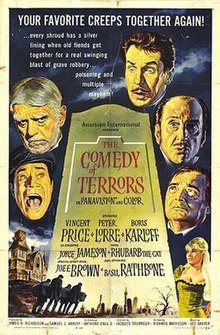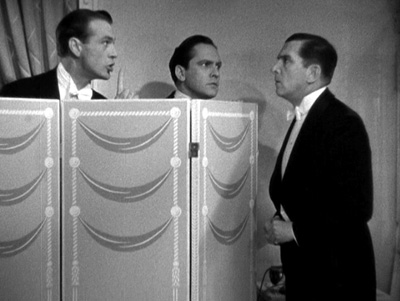What I’ve Been Watching: The Beast with Five Fingers (1946).
Who’s Responsible: Robert Florey (director); Curt Siodmak (screenwriter); Robert Alda, Andrea King, Peter Lorre (stars).
Why I Watched It: SILVER.
Seen It Before? At least once, long ago.
Likelihood of Seeing It Again (1-10): 10.
Likelihood the Guys Will Rib Me for Watching It (1-10): 1.
Totally Subjective BOF Rating (1-10): 6.
And? With SILVER well underway, I’m herewith launching a complementary, as-yet-unnamed initiative aimed straight at the heart of the nexus: since my LD programming is predetermined, why not avail myself of the opportunities for some long-overdue page-to-screen comparisons? The title story of W[illiam] F[ryer] Harvey’s second collection, The Beast with Five Fingers and Other Tales (1928), debuted in the first volume of The New Decameron (1919), and is presumably the now-obscure British author’s greatest claim to fame. He died in 1937 at only 52, and appears to have no other screen credits apart from episodes of four different TV series based on “August Heat,” all between 1950 and 1961.
I thought I might have read this one as a lad in Peter Haining’s The Ghouls, which Mom used to bring home from the library and was, as you may imagine, a seminal tome for me, collecting eighteen stories adapted into horror films. But perusing it now—and having it readily to “hand” in Sebastian Wolfe’s Reel Terror—I strongly suspect that I would have remembered how different it is. The task faced by Siodmak (reportedly with uncredited additional dialogue by Harold Goldman, among the screenwriters of the 1940 Dorothy L. Sayers adaptation Haunted Honeymoon) was not only to expand the fairly limited story to feature length, but also to change its tone from borderline whimsy to actual gothic horror.
Fryer’s unnamed narrator introduces botanist Adrian Borlsover and his nephew, Eustace, “who lived in the gloomy Georgian mansion at Borlsover Conyers, where he could work undisturbed in collecting material for his great book on heredity.” Visiting Adrian at his “sunny south-coast watering place,” Eustace learns that his uncle, who has had extraordinary powers of touch since losing his sight at 50, has “developed, unknown to himself, the not uncommon power of automatic writing.” While Adrian traces Braille with his left hand, the right begins communicating independently with Eustace, asserting friendship and that they will see each other “when poor old Adrian’s dead,” which happens two months later.
Eustace receives a box containing what is presumed to be a live specimen, which escapes unseen, and a letter from the family solicitor, explaining that in addition to leaving him a “valuable collection of books,” Adrian had instructed—in a bequest apparently written by the “beast” itself—that his right hand be sent to Eustace! Sure enough, the escaped “rat” is the digital demon, wreaking havoc among Eustace; his secretary, Saunders; the butler, Morton; and the other servants, who threaten to walk. Stowing away in a glove, the beast follows Eustace to Brighton, crawls down a chimney and—as Saunders seeks help to put out an accidental blaze—creeps, “black and charred,” to exact its vengeance on Eustace…
How much of this Fryer expected us to take seriously I don’t know, but while the narrator says that the story Saunders told him is “practically uncorroborated,” a chance meeting in the Zoological Gardens with Morton, still shaken by the experience, seems to confirm it. At any rate, there is very little to the story, and even less remaining in the film, excepting some choice bits of business like the hand getting nailed onto a board and imprisoned in a safe, or knocking books off the shelves as it scurries behind them in the library. Perhaps inspired by Eustace reading of Adrian’s death while in Naples, Siodmak resets the tale in an Italian village, San Stefano, with J. Carrol Naish as its Commissario, Ovidio Castanio.
Here, the hand belongs to pianist Francis Ingram (Victor Francen), who lost the use of the other in a stroke and has grown quite attached to his attractive nurse, Julie Holden (King). That’s fine with his secretary, Hilary Cummins (Lorre, effectively conflating Eustace and Saunders), giving him more time to focus on his research into astrology, but Julie appears more interested in Bruce Conrad (Alda, whose character is inexplicably billed as “Conrad Ryler”), a charming rogue who dabbles in fake antiques, and transcribed Bach for Ingram to play with his good hand. When Hilary unwisely draws Ingram’s attention to this, he is throttled hard enough to leave fingerprints on his neck, his life saved by her intervention.
No sooner has Ingram’s wheelchair taken a tumble downstairs than his slimy brother-in-law, Raymond Arlington (Charles Dingle), and nephew, Donald (John Alvin), sleaze in, expecting to inherit, even the books for which Hilary has a decidedly proprietary feeling. But they get a surprise when lawyer Duprex (David Hoffman) reads the recently revised will, leaving everything to, you guessed it, Julie. In a flash, the shyster and the in-laws—there’s a combo—are flinging accusations of incompetence, insanity and/or conspiracy, hoping to revert to the prior will in Ingram’s safe…if only Donald can recall the clever mnemonic Uncle Francis taught him for the combination; cue the ghostly piano playing.
[L-R: Naish, Alda, King, Lorre]
Seeing a light in the mausoleum, they find Ingram’s body minus one hand, the blade that evidently severed it still clutched in the other, while the strangulations of Duprex (fatally) and Donald (not so much) implicate the beast, with which Hilary comes face to, uh, face. The servants resign en masse, yet in a cheat that annoyed Madame BOF and me, Hilary is revealed to have committed the crimes himself, aided by a recording of Francis playing, and imagined the living hand that, as in the story, is thrown into the fire, then emerges to choke him to death. In a final indignity, Castanio jokes to the camera about ghosts, even faking an attack by a hand revealed to be his own as the camera pulls back; womp womp.
Q: What do Humphrey Bogart, James Bond, Frank Capra, Roger Corman, Cary Grant, Alfred Hitchcock, John Huston, Boris Karloff, Fritz Lang, Richard Matheson, Edgar Allan Poe, Vincent Price, Basil Rathbone, and Jules Verne have in common, besides my esteem? A: Peter Lorre. If you’ll forgive a juicy digression—hell, it’s my blog, I’ll do whatever I want—he’s one of those guys I’ve long loved not only in his own right, but also because his career intersected those of so many other faves. I was jazzed to revisit this after many years, especially since it was before he bulked up, apparently a side-effect of health and substance-abuse issues that no doubt contributed to his death at 59 in 1964.
You want famous firsts? In 1954, he played the very first Bond villain, Le Chiffre, in an episode of Climax! based on Casino Royale. The following year, he appeared in “Young Couples Only,” an episode of Studio 57 that is almost certainly the very first Matheson adaptation ever…playing a character (above) explicitly compared to Lorre in the original story! Following the SF-heavy 1950s, he and fellow Golden Age horror stars such as Karloff and Rathbone got a welcome career boost when AIP teamed them with Price (who read the eulogy at Lorre’s funeral) in Matheson’s Tales of Terror (1962), The Raven (1963)—both based on Poe’s work and directed by Corman—and The Comedy of Terrors (1963, below).
[I actually have this poster, by the way. I took it as a “parting gift” when my erstwhile employer, GoodTimes Entertainment, was mismanaged into bankruptcy and acquired by bloodsucking leeches who laid most of us off. As I said more or less on my way out the door, “What are they going to do, fire me?”]
Boris and Peter were no strangers, also joining forces in You’ll Find Out (1940) with Bela Lugosi; The Boogie Man Will Get You (1942); and the legendary 1962 Route 66 episode “Lizard’s Leg and Owlet’s Wing” with Lon Chaney, Jr. They should have shared screen time opposite Grant in Capra’s Arsenic and Old Lace (1944)—recent SILVER viewing—but the producers who mandated that Warner Brothers shelve the film until its Broadway run ended also refused to let Boris take a hiatus to recreate his role onscreen, as several of his co-stars did. Lorre played Mr. Moto (below) in eight entries (1937-9), also appearing in genre films like Karl Freund’s Mad Love (1935) and, as another Asian, Invisible Agent (1942).
As if that’s not enough, Lorre worked with my favorite director AND actor. After fleeing Hitler ended his German career, with its star-making turn as the child-killer in Lang’s M (1931), he made his English-language debut as the villain in the first Man Who Knew Too Much (1934), later appearing in Secret Agent (1936) and two episodes of Hitchcock’s TV series, “The Diplomatic Corpse” and “Man from the South.” The indelible Joel Cairo in Huston’s The Maltese Falcon (1941, below) and the doomed Ugarte in Casablanca (1942) were the highlights of his collaborations with Bogie, also including the delightful All Through the Night (1942), Passage to Marseille (1944), and Huston’s spoof Beat the Devil (1953).
Even slumming with Irwin Allen in the likes of Voyage to the Bottom of the Sea (1961) and the Verne-based Five Weeks in a Balloon (1962), Lorre always brought something to the table. His other and—virtually by definition—better Verne adaptations were 20,000 Leagues under the Sea (1954, below) and Around the World in Eighty Days (1956). The Beast with Five Fingers is perhaps not his finest hour, but nobody does overwrought like Lorre; he, the special effects (still so impressive that I’m not sure how William McGann and H. Koenekamp pulled them off), and the atmosphere Florey achieves with cinematographer Wesley Anderson, in one of his only features, are in my opinion the film’s greatest assets.
Nowadays, at least in my circles, Florey gets more ink for being the guy who didn’t direct Lugosi in Frankenstein (1931)—whereupon Universal threw them Poe’s Murders in the Rue Morgue (1932) as a compensatory bone—than for his own work, but I won’t go there. He co-directed the Marx Brothers’ first film, The Cocoanuts (1929, below), known for its innovative production numbers, and had already worked with Lorre in The Face Behind the Mask (1941), a film noir with horrific overtones. Florey followed many a Hollywood vet into television at the end of his career, directing episodes of Thriller (“The Incredible Doktor Markesan”), Alfred Hitchcock Presents, The Twilight Zone, and The Outer Limits.
This was a rare horror outing for Warner, befitting a seeming discomfiture with the genre, and ended Lorre’s tenure there, arguably his peak. Conrad was reportedly written for and declined by his Casablanca co-star Paul Henreid, yet at least as filmed, the role seems far better suited to Alda (father of Alan), who plunged from originating Sky Masterson in my favorite Broadway musical, Guys and Dolls—recast with Marlon Brando in the 1955 film version’s fatal flaw—to Mario Bava’s bastardized House of Exorcism (1975). Ironically, Henreid directed Lorre’s Raven co-star Hazel Court in “The Terror in Teakwood” (below), a 1961 Thriller episode concerning a mad concert pianist and severed hands that, um, run amok.
I think my hands would be inclined to run amok as well…























